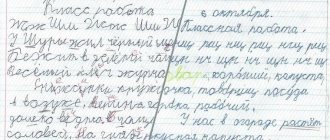Impaired written speech in younger schoolchildren
Currently, the problems of studying, diagnosing and correcting written speech disorders in children are among the most pressing tasks of pedagogy and speech therapy. This article analyzes the main reasons for the manifestation of persistent specific errors in the written work of primary schoolchildren, provides a classification of dysgraphia, and also describes the directions of correctional work with children with these disorders.
The problem of written speech disorders in schoolchildren is one of the most pressing for school education. About 40% of children from the total number of primary school students have one or another type of written language disorder (dysgraphia). Therefore, the problem of providing assistance to children with writing disorders remains urgent. In this regard, the purpose of this article is to comprehensively analyze the main disorders of written speech in primary schoolchildren.
So, the process of mastering written speech is in close interaction with the degree of formation of all aspects of oral speech: sound pronunciation, phonemic perception, lexical and grammatical aspects of speech, coherent speech. It follows that the cause of dysgraphia can be the same functional and organic disorders that cause oral speech disorders.
Also in the development of dysgraphia, one can note socio-psychological factors, such as a deficit of speech contacts, inattention to the child’s speech on the part of adults, unjustifiably early learning to read and write in the absence of a child’s psychological readiness, which contribute to the occurrence of disorders in the development of written speech.
The key to successful mastery of writing lies in a sufficiently high level of development of oral speech. But it is worth noting that, unlike oral speech, written speech can only develop under the condition of systematic and targeted training [1, p. 7].
The main sign of dysgraphia is typical and repeated errors in writing of a persistent nature, not related to ignorance of the rules and norms of the language. Such errors include: mixing and replacing graphically similar handwritten letters (sh-sch, t-sh, v-d, m-l) or phonetically similar sounds (b-p, d-t, g-k, sh- and); distortion of the letter-syllabic structure of a word (omissions, rearrangements, addition of letters and syllables); violation of the unity and separateness of the spelling of words; agrammatisms in writing (violation of inflection and agreement of words in a sentence). Children with dysgraphia have a low writing speed, difficult to distinguish handwriting, fluctuations in the height and inclination of letters, slipping from the line, etc. The presence of dysgraphia is diagnosed at the age of 8–9 years [4, p. 131].
Classification of dysgraphia is carried out on the basis of various criteria: taking into account impaired analyzers, undeveloped writing operations, and mental functions. Thus, the following types are distinguished:
- Articulatory-acoustic. These disorders are due to the fact that children pronounce sounds incorrectly, which means that when they pronounce them to themselves, they write them down incorrectly. To treat this type of dysgraphia, it is necessary to work on the correct pronunciation of sounds.
- Acoustic. Here children pronounce sounds correctly, but confuse them with similar sounds (voiceless-voiced: b-p, d-t, z-s; hissing: s-sh, z-z; and are also unable to distinguish the softness of individual sounds).
- Optical. Children with optical dysgraphia have difficulty writing and distinguishing letters: they add extra elements (sticks, lines, circles), skip the necessary ones, and can write in a mirror image in the opposite direction).
- Dysgraphia due to problems of language analysis and synthesis. Children with such a problem in writing may skip or repeat entire words, rearrange syllables and letters, write different words together (confuse prefixes and prepositions of nouns, attach part of the next word to one word, etc.).
- Agrammatic dysgraphia. Such violations are detected after grades 1–2, as they require greater knowledge of the rules of spelling words. This problem is due to the fact that children cannot correctly inflect words by gender and case, and cannot agree on an adjective and a noun (“good dog”, “beautiful field”, etc.). This problem can be observed in bilingual (bilingual) families, as well as when a child is taught in a non-native language [2, p. 56].
Overcoming dysgraphia requires coordinated work of a neurologist, speech therapist, teacher, child and his parents. Impaired written speech will not disappear on its own; mandatory work is required to eliminate this defect. In order to improve a child’s written speech, it is necessary to diagnose and fill gaps in the pronunciation of sounds, phonemic perception, develop the grammatical aspect of speech and expand the child’s vocabulary.
Dysgraphia correction classes include:
− work on correct articulation and reproduction of sounds;
− phonemic hearing training;
− analysis of sounds, as well as work on understanding the sound-letter composition of a word;
− writing training includes regular dictations, searching for letters indicated by the teacher in the text, word games, memorizing the spelling of letters;
− exercises for fine motor skills and improvement of interhemispheric connections also occupy an important place [3, p. 135].
All speech therapy classes are built with mandatory consideration of the child’s psychological characteristics, his speech development and the type of manifestations of dysgraphia. In addition, it is important to develop in the student a positive attitude towards work and the psychological component of speech, to stimulate him to study and achieve results.
Of course, an important place is given to the prevention of violations. Prevention of dysgraphia must begin in preschool age. Preventive work should include the targeted development of higher mental processes, spatial concepts, auditory and visual differentiation, and graphomotor skills. Timely correction of oral speech disorders is of great importance.
So, writing disorders (dysgraphia) in children of primary school age have been studied for a long time, but even now it is one of the most pressing problems in pedagogy and speech therapy, because dysgraphia is one of the most common forms of speech pathology in primary schoolchildren. Writing disorders affect the entire learning process and speech development of children. Timely identification of these disorders and precise determination of their pathogenesis in each individual case is extremely important for the development of speech therapy work with children.
Literature:
- Dubynina T. E. Causes of dysgraphia in younger schoolchildren // Modern psychology and pedagogy: problems and solutions: collection. Art. by mother XVII international scientific-practical conf. No. 12(16). - Novosibirsk: SibAK, 2022. - pp. 7–10.
- Kornev A. N. Dyslexia and dysgraphia in children. — 3rd ed. - St. Petersburg: Hippocrates, 2012. - 224 p.
- Melyukhanova E. E. Correction of dysgraphia in younger schoolchildren // Innovative science. - 2022. - No. 5. - P. 132–137.
- Sadovnikova I. N. Impairments in written speech and their overcoming in primary schoolchildren. - M., 1997. – 300 p.
PREFACE
The problem of violations of written speech is revealed in theoretical and practical aspects. The author introduces readers to the reasons for the occurrence of these disorders in schoolchildren, and proposes an original system of work to overcome impairments in written speech, taking into account modern requirements for the content of school education.
For speech therapists, Russian language teachers, students of defectology faculties and primary education faculties of pedagogical universities.
The problem of impaired writing in schoolchildren is one of the most pressing for school education, since writing and reading from the purpose of primary education turn into a means of further acquisition of knowledge by students.
The book reflects the results of many years of scientific and practical activity of the author, developing the problem of writing and reading disorders in relation to the population of students in secondary schools and, mainly, primary classes, because the main task of a school speech therapist is to promptly identify and overcome disorders of written speech, preventing their transition, complicating the educational and cognitive activity of students, to subsequent stages of education.
The first section of the book covers the prerequisites for the formation of writing and reading normally and the mechanisms of disorders leading to persistent specific errors in written speech; The revealed typology of such errors is illustrated by examples from student works. An original system for identifying and recording specific writing errors by a speech therapist is presented. The criteria for distinguishing dysgraphia from immaturity of writing skills, characteristic of the stage of literacy acquisition, are described. Diagnostic tasks are proposed to identify dysgraphia in students in grades 1–3. Materials from a comprehensive study of schoolchildren with dysgraphia are presented, characterizing the state of a number of their sensorimotor and gnostic functions that are important for the development of written speech.
The second section reveals a system of correctional education to overcome written language disorders - in four main areas. Each chapter is preceded by the necessary methodological commentary, defining the tasks and methods of organizing the proposed types of work. The range of topics, content and forms of work are determined by the specifics of speech therapy tasks, but at the same time they correlate with the key issues of the Russian language program in primary school.
Dysgraphia in children: what is it?
How to distinguish dysgraphia from ordinary illiteracy
The problem of impaired writing in primary schoolchildren is one of the most pressing, since writing becomes the main means of acquiring new knowledge and a skill that determines the success of further education.
When children first begin to master written language, they often write with errors. How can you understand that the reason for mistakes in writing is not laziness and unwillingness to learn the rules, but that the child has dysgraphia and needs the help of a speech therapist?
According to the definition (Sadovnikova I.N.), dysgraphia is a partial specific writing disorder, the main symptom of which is the presence of persistent errors characteristic of this condition.
Specific errors in writing are those that do not disappear on their own in the process of regular practice, as the child masters the lexical and grammatical norms and rules of the language. They are eliminated during long-term, targeted correctional speech therapy work.
What symptoms or errors in writing in children are a manifestation of dysgraphia:
- The child does not understand how to write the letter correctly. He can write it the other way, leave out some element, or replace it with another, similar one, and not notice it. Often children with dysgraphia mix up and confuse the spelling of a and o , i and w , b and d , d and u , m and l , etc. This is how “byatel”, “shuka”, “mokot”, etc. appear in notebooks.
- Confuses letters denoting similar sounds, for example, voiced and voiceless consonants , s and sh , z and zh , chic , ril , o and u . So, a child writes “Serkei” instead of “Sergey”, “straw” instead of “straw”, “grandfather” instead of “grandfather”, “loves” instead of “loves”, etc. It often turns out that the child made the same mistakes earlier in oral speech, but over time they disappeared, often in the process of targeted speech therapy intervention.
- Does not complete words, skips, rearranges or adds extra sounds and syllables. We are now not talking about omissions of letters when consonants coincide in words like sun or honestly, when you need to know the spelling rule of an orthogram and use it in practice, but about omissions of sounds that would seem to be clearly audible, for example, in stressed vowels. So the word “cow” turns into “krva”, “fox” into “faces”, “crow” into “rowona”, “brother” into “bart”, “girl” into “girl”, etc.
- Doesn't know how to agree words. For example, it can write “good cat” or “the children ran away.”
- Cannot correctly separate sentences into words. Words merge with each other, and part of the word may “fall out.”
- Doesn't understand where one sentence ends and another begins, and what punctuation mark should be put at the end.
The number of specific errors increases with the gradual complication of the material, i.e. manifestations of dysgraphia are intensifying. Therefore, dysgraphia often becomes noticeable in the second or third grade, when it becomes an obstacle to mastering the material of the educational program in various subjects.
Academic difficulties are growing like a snowball. As a result, due to frequent failures and bad grades, the child develops and consolidates a “loser” complex.
Therefore, it is very important during the first days of learning to read and write in elementary school to pay attention to the nature of the child’s mistakes in writing.
You should also not start teaching your child to write at the age of 4-5, because... At this age, most children are not ready to master writing, and parents’ excessive insistence can only do harm and cause a persistent dislike for learning.
If you notice specific errors and manifestations of dysgraphia in your child’s notebook, you need to contact a speech therapist as soon as possible. He will conduct an examination, determine the cause and nature of the writing disorder, and develop a plan for pedagogical and speech therapy assistance.
Symptoms and classification of writing disorders according to Sadovnikova
I. N. Sadovnikova took the Borel–Mesoni classification as a basis . She identified the following types of dysgraphia: dysgraphia associated with oral speech disorders, dysgraphia caused by difficulties in spatial orientation, mixed form. In addition, Sadovnikova identified evolutionary or false dysgraphia. It is a manifestation of children’s natural difficulties during initial learning to write, which is associated with the complexity of this type of speech activity.
A study of modern foreign literature on this issue shows that the problem of reading and writing disorders in children is currently very relevant.
According to foreign authors, the number of children with reading and writing disorders in different countries is quite large. This is indicated in their works by Bond and Woolf (l957), Monroe (1963), Becker (1967).
According to Becker, in first-level classes of a normal public school, 3% of children have deficiencies in reading and writing, and in first-level classes of speech schools - 22%.
Most foreign authors associate reading and writing disorders in children with various brain diseases in aphasic and dysphatic disorders and with delayed speech development in children.
In modern foreign literature, Mopgo's work “Children Who Can't Read” (London, 1963) is of great interest. The author seeks to trace the causal factors that cause reading defects. He notes that these defects may be associated with the visual aspect (difficulty in distinguishing complex visual images), the auditory aspect (inaccuracy in distinguishing speech sounds by ear), and the motor aspect (the child does not retain visual symbols and does not form the necessary associations).
The author also draws attention to reading defects caused by improper teaching (methodological aspect). The requirement of excessive speed when reading leads to the formation of incorrect reading skills (reading by guessing, with missing letters and syllables, etc.).
When studying the above works of domestic and foreign authors, it shows that the problem of dyslexia and dysgraphia in children is relevant, but is far from fully developed. Foreign authors, without using in their views on the issue under discussion the teaching of I. P. Pavlov about two signaling systems in brain activity and their interdependence, speak about the psychophysiological mechanisms of dysgraphia in an extremely inaccurate and contradictory manner.
In the works of A. R. Luria and S. S. Lyapidevsky, the mechanisms of writing and reading are considered from the perspective of modern neurophysiology.
As is known from neurology, at the end of the last century writing was viewed very simplistically, as a purely motor process that is easily based on a narrowly limited area of the cerebral cortex. Researchers of that time, along with the centers of visual functions, centers for auditory and motor speech, also spoke about a special “writing center” (the so-called Exner center). In their opinion, this center was located in the middle part of the motor area of the left hemisphere. However, this idea cannot be completely accepted from the standpoint of modern physiology. The mechanism of the reading and writing processes is undoubtedly dynamic, emerging gradually. In the process of learning to read and write, stable automated writing and reading skills are developed. “The basis of their formation,” writes S. S. Lyapidevsky, “is a chain of conditioned reflexes layered on top of each other and interconnected. Thus, the gradual formation of temporary connections (conditioned reflexes) creates certain dynamic stereotypes in the process of learning to read and write, which in the language of psychology is defined by the concept of “skill”.
In domestic speech therapy, as a rule, a symptom complex of writing disorders is described, and correctional work is based not on the form of the disorder, but on the typology of errors, this is due to the fact that in students’ works there are errors of various types related to different forms of dysgraphia.
A group of leading scientists (R.E. Levina, N.A. Nikashina, G. Kashe, L. F. Spirova, G.V. Chirkina, I.K. Kolpovskaya, A. V. Yastrebova, etc.) proved that there is a direct the relationship between the level of speech development of a child and his ability to master literacy. An analysis of the written work of primary school students who are unsuccessful in the Russian language allowed them to identify four groups of specific errors:
1. Substitutions of letters (“bopeda” instead of “victory”, “Tanu” instead of “Tanya”, “saw” instead of “dust”, “tistit” instead of “cleans”...).
2. Violations of the syllabic structure and sound content of words (“kichat” instead of “shout”, “sit” instead of “sits”, “dovr” instead of “yard”, “bart” instead of “brother”...).
3. Violations of the use of lexical and grammatical categories:
a) combined spelling of auxiliary and significant words (“at the pine tree” - “usosny”, “svetitluna” instead of “the moon is shining”);
b) omission and replacement of prepositions (“the vase is on the table”, “the ball fell and the table”);
c) violation of the agreement of adjectives and numerals with nouns (“five tables”, “dirty shirt”);
d) mixing of case endings (“went for a ride in a car”, “treated a tooth”).
4. Errors in sentence construction:
a) omission of both the main and secondary members of the sentence (“Sasha fished.” “We started skiing”);
b) separate writing of the main and subordinate clauses (“When winter came. The children came to sled and skate”);
c) using a subordinate clause without a main clause (“If it rains”).
In the studies of domestic scientists (R.E. Levina, L.F. Spirova, N.A. Nikashina, etc.), the above-described writing disorders are considered as a result of insufficient preparedness of the early stages of speech development for the transition to its subsequent stages, i.e. as a result of underdevelopment of the child’s oral speech. Even before entering school, a normally developing child forms practical generalizations about the sound and morphological composition of a word, which prepares him for mastering the skills of competent spelling. Therefore, pronounced disturbances in the development of speech entail serious deviations in the formation of writing.
The nature of the errors is primarily due to two reasons:
a) insufficient level of development of phonemic hearing;
b) problems in the development of lexical and grammatical components of the language.
The main types of errors include violation of the sound-syllable structure of a word,
Thus, the most justified, in our opinion, is the classification of dysgraphia, which is based on the immaturity of certain operations of the writing process. The following types of dysgraphia are distinguished: articulatory-acoustic, based on violations of phoneme recognition (differentiation of phonemes), based on violations of language analysis and synthesis, agrammatic and optical dysgraphia.






